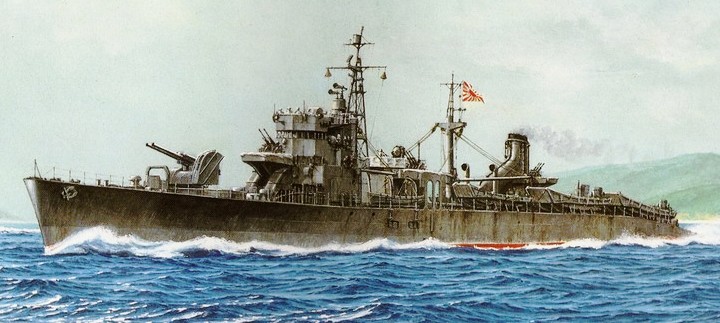Dai 1 Go-gata Yusokan
IJN No. 1 Class Fast Transport
 (No. 1 Class Fast Transport T.5 by T. Yuki)
(No. 1 Class Fast Transport T.5 by T. Yuki)
IJN Transport T.19:
Tabular Record of Movement
© 2014-2015 Bob Hackett and Sander Kingsepp
4 January 1945:
Kure Naval Arsenal. Laid down as Ship No. 2919, a 1,500-ton
No. 1 class landing ship.
8 January 1945:
Numbered T.19
18 February 1945:
Lt Shibata Tadashi (former gunnery officer of YUKIKAZE)
is appointed Chief Equipping Officer.
24 February 1945:
Launched.
16 May 1945:
Completed. Assigned to the 31st Naval Transportation Unit.
Lt Shibata Tadashi is the Commanding Officer.
16 May 1945:
While returning from a "Kaiten"-ferrying sortie to Urato Islands,
NE coast of Honshu, T.19 is grounded in Sukumo Bay. A tug is dispatched from Kochi,
Shikoku, to tow her to Kure. [1]
22 May 1945:
Arrives at Hirao Naval Base, Inland Sea. Scheduled to ferry
"Kaiten" human torpedoes from Hirao to various bases on south coast of Shikoku and east
coast of Kyushu. Departs
Hirao on her second "Kaiten"-ferrying mission to Urato Islands, carrying eight human
torpedoes.
23 May 1945:
Arrives at Urato, unloads her cargo.
24 May 1945:
Departs Urato for Sukumo Bay, arriving that same evening.
August 1945:
Kure. Survives the war. Surrendered to the Allied
Occupation Forces.
26 August 1945:
Designated as transport vessel, 1st Reserve.
12 October 1945:
Departs Kure for Palau.
20 October 1945:
Arrives at Palau, departs for Uraga the following day.
28 October 1945:
Arrives at Uraga.
29 October-8 November 1945:
Undergoes repairs at Ishikawajima shipyard.
10 November 1945:
Departs Uraga for Guam.
15 November 1945:
Arrives at Guam.
17 November 1945:
Departs Guam for Uraga.
24 November 1945:
Arrives at Uraga.
29 November-12 December 1945:
Undergoes repairs at Asano shipyard.
1 December 1945:
Removed from the Navy List. Designated as special
transport/repatriation vessel No. 19. Assigned to the Allied Repatriation Service. [2]
22 December 1945-20 February 1946:
Undergoes repairs at Ishikawajima shipyard.
1-31 May 1946:
Undergoes additional repairs and refit at the former Kure
Naval Arsenal.
3 June 1946:
Departs Sasebo for Korojima (near Tsientsin).
8 June 1946:
Arrives at Korojima, departs for Hakata the following day.
12 June 1946:
Arrives at Hakata.
11 July 1946:
Departs Hakata for Korojima.
15 July 1946:
Arrives at Korojima, departs for Hakata the following day.
19 July 1946:
Returns to Hakata.
25 July 1946:
Departs Hakata for Korojima.
28 July 1946:
Arrives at Korojima.
30 July 1946:
Departs Korojima for Hakata.
3 August 1946:
Returns to Hakata.
12 August 1946:
Departs Hakata for Korojima.
15 August 1946:
Arrives at Korojima.
19 August 1946:
Departs Korojima for Hakata.
22 August 1946:
Returns to Hakata.
13-29 September 1946:
Undegoes repairs at Harima shipyard.
15 October 1946:
Transferred to Yokohama for a repatriation cruise to
Ballale (Balalae) Island, Solomons. Departs on that day, but is diverted to Guam for
powerplant repairs and fuel replenishment.
20 October 1946:
Arrives at Guam.
26 October 1946:
Arrives at Uraga, carrying some 600 repatriants.
28 October-11 November 1946:
Undergoes repairs at Uraga.
28 October-11 November 1946:
Departs Uraga for Guam (arrives on the 22nd),
makes a brief stop at Okinawa (27th November) and returns on the 30th November.
11 December 1946:
Departs Uraga for Guam.
17 December 1946:
Arrives at Guam, departs for Uraga on the 19th December.
23 December 1946:
Returns to Uraga.
7 September 1947:
Former IJN Capt (Retd) Ogata Tomoe (50)(former CO of
Keelung Guard Unit) is appointed the CO.
20 November 1947:
Stricken from the list of repatriation vessels.
1947-1948:
Taiyo Fishery Co., Ltd.. operates T.19 and the former
T.16 as whaling mother ships off the Ogasawara Islands (Bonin) Islands. They
transport whale meat to Tokyo.
26 June 1948:
Ceded to the United Kingdom as a war reparation.
1948:
Sold for scrap.
October-December 1948:
Scrapped at Uraga.
Author's Notes:
[1] Little data were found for T.19's wartime movements.
Readers with access to any such data are requested to post the information on
the Discussion and Questions board or j-aircraft.org's IJN Ship Message Board
[2] Allied occupation forces were responsible for the return of six
million Japanese military personnel and civilians from Japan's defunct
far-flung Empire. In addition, there were over a million Korean and about
40,000 Chinese prisoners and conscript laborers and approximately 7,000
Formosans and 15,000 Ryukyu Islanders to be repatriated.
Some Allied and many former IJN warships, from aircraft carriers to
kaibokan, were used to facilitate the enormous repatriation effort. Japanese
vessels and crews were used to the fullest extent possible to conserve Allied
manpower and accelerate demobilization. Each ex-IJN ship first had to be
demilitarized; guns removed or, in the case of large warships, barrels severed,
ammunition landed, and radar and catapults removed, if fitted. Repatriation of
the Chinese on Japanese ships began early in October from Hakata, but U.S.
guard detachments had to be placed on many ships to prevent disorder because
the Japanese crews could not control the returnees.
Japanese-run repatriation centers were established at Kagoshima, Hario
near Sasebo, and Hakata near Fukuoka. Other reception centers were established
and operated at Maizuru, Shimonoseki, Sasebo, Senzaki, Kure, Uraga, Yokohama,
Moji and Hakodate. Allied line and medical personnel supervised the centers.
Incoming Japanese were sprayed with DDT, examined and inoculated for typhus and
smallpox, provided with food, and transported to their final destination in
Japan.
-Bob Hackett and Sander Kingsepp
Back
to Fast Transport Page





